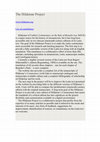Digital Projects by Bruce Venarde

by Albrecht Diem, Matthieu van der Meer, Matthew Gillis, Abigail Firey, Irene van Renswoude, Clare Woods, Zachary Yuzwa, Marijana Vukovic, Columba Stewart, Eric Shuler, Manu Radhakrishnan, Matthew Ponesse, Abraham Plunkett-Latimer, Alexander O'Hara, Rob Meens, Sven Meeder, James LePree, Kathryn Jasper, Andrew Irving, Julie Hofmann, Zachary M Guiliano, Brendan Cook, Isabelle Cochelin, Susan Boynton, Courtney Booker, Daniel Abosso, Bruce Venarde, Corinna Prior, and Mariel Urbanus http://hildemar.org/
http://hildemar.org
Hildemar of Corbie's Commentary on the Rule of Benedict (ca. 845CE) is a m... more http://hildemar.org
Hildemar of Corbie's Commentary on the Rule of Benedict (ca. 845CE) is a major source for the history of monasticism, but it has long been accessible only in two obscure nineteenth-century editions of its Latin text. The goal of the Hildemar Project is to make the entire commentary more accessible for research and teaching purposes. The first step is to provide a fully searchable version of the Latin text along with an English translation. This translation is a collaborative effort of more than fifty scholars, including specialists in monasticism, Latin, manuscripts studies, and Carolingian history.
Currently a slightly revised version of the Latin text from Rupert Mittermüller’s edition [Regensburg, 1880] is available on the site. The translation of all seventy-three chapters – one for each chapter of Benedict’s Rule – is now complete.
The website also provides a complete list of the manuscripts of Hildemar’s Commentary (with links to manuscript catalogues and manuscripts available online) and a complete bibliography of scholarship on Hildemar and his work.
The next step in the project will be to improve the Latin text presented on the website by providing links to the different versions of Hildemar’s work. Users will be able to compare the (problematic) nineteenth-century edition with the original manuscripts. A long-term goal of the Hildemar Project is to provide a new edition of Hildemar’s Commentary that meets the standards of a critical edition but also capitalizes on the greater flexibility and customization available in a digital environment.
The Hildemar Project is a collaborative project that profits from the expertise of as many scholars as possible and is tailored to the needs and interests of its users. Any form of feedback, suggestions for improvement, identification of sources, or commentary on the Latin text are welcome. Please either use the Forum or contact us directly.
Papers by Bruce Venarde
Brepols Publishers eBooks, 2013
Journal of the American Academy of Religion, Dec 1, 2021

Harvard University Press eBooks, 2011
One of the most influential texts in the Middle Ages, The Rule of Saint Benedict offers guidance ... more One of the most influential texts in the Middle Ages, The Rule of Saint Benedict offers guidance about both the spiritual and organizational dimensions, from the loftiest to the lowliest, of monastic life. This new Latin-English edition has features of interest for first-time readers of the Rule as well as for scholars of medieval history and language. The Latin text is a transcription of manuscript 914 of the Abbey of St. Gall (Switzerland), an early ninth-century copy regarded as the version that most closely reproduces Benedict's style. The saint's idiom was informal, sometimes conversational, and heavily influenced by the spoken Latin of the sixth century CE. In the Rule his voice and thought processes come through in all their strength and humanity. Readers will find background to the monastic life in the notes. This volume also includes texts and translations of two letters that explain the origins of the St. Gall version as well as an index to all the translated materials.
The Medieval Review, Jun 1, 2010
The Medieval Review, Feb 1, 2003
The Medieval Review, Jul 1, 1998
Biography, 2000
' 183 poems, and mythological texts originating in the West Norse tradition on Iceland and in Nor... more ' 183 poems, and mythological texts originating in the West Norse tradition on Iceland and in Norway. But times do change, and Old Swedish literature will one day have its moment in the sun, and on its own terms. After all, it was just over a hundred years ago that W. P. Ker wrote famously of the Old Norse courtly sagas-several of which are included in Norse Romance-that they were "among the dreariest things ever made by human fancy." This collection of Arthurian texts is anything but dreary, and it represents a major contribution, not only to the Old Norse field, but to the broader world of medieval literature and culture. Norse Romance will endure for years to come.
Journal of the History of Sexuality, 2008
Catholic Historical Review, 2021
Catholic Historical Review, 2022
Here lies buried Ruothildis, spouse of the Redeemer but her soul rejoices upwards. When she was i... more Here lies buried Ruothildis, spouse of the Redeemer but her soul rejoices upwards. When she was in this world, this most chaste virgin shone immaculate abbess of the virgin choir. She remained a comely canoness under the holy veil but in life she was a true nun. Having died on the Kalends of December she returned to the husband to whom she had piously committed herself. 3 Today, Ruothildis's tombstone is on display at Trier's Rheinisches Landesmuseum, where it is presented as one of the highlights of Ottonian epigraphy. While visitors may marvel at the quality of the carving and the elegance of the script, for historians the epitaph pres ents a conundrum, even if most commentators have failed to acknowledge its significance. 4 Indeed, much of the text duly acknowledges the tropes central to clerical discourse around 1000,
Church History, Sep 1, 2020

Catholic Historical Review, 2017
Reviews 201 historical, political, and legal-an o p p o rtu n ity n o t necessarily afforded by s... more Reviews 201 historical, political, and legal-an o p p o rtu n ity n o t necessarily afforded by single-discipline studies. H ow ever, th e n o n-a rt historians am ong the co n trib u to rs are n o t always adept in discussing th e visual aspects o f the m anuscrip ts, som e ten d in g to in te rp re t illustrations to o literally and w ith o u t reg ard for stylistic differences, p icto rial convention, o r artistic practice. T he b o o k is w ell illu strated , although several rep ro d u ctio n s are o f p o o r quality, and captions 1.12 and 1.13 have b e e n sw itched. All o f th e co n trib u tio n s are thoughtful and w ell argued, and th e volum e p resents a range o f te x ts and illustrations n o t usually considered together. C are has also b een taken to m ake th e volum e accessible to m any re a d e rs: a sum m ary in F rench appears at th e beginning of each chapter, and ex tracts o r quotes in F rench are follow ed by English translations. T he am bitious, overarching them es o f p ow er and justice could well have re su lte d in a disparate collection o f m iscellaneous essays; th e ed ito rs are to b e co m m en d ed fo r a coherent, original collection th a t m akes an original and substantial co n trib u tio n to an under-co n sid ered field o f study and w ill b e o f g reat in te re st to scholars from m any disciplines.











Uploads
Digital Projects by Bruce Venarde
Hildemar of Corbie's Commentary on the Rule of Benedict (ca. 845CE) is a major source for the history of monasticism, but it has long been accessible only in two obscure nineteenth-century editions of its Latin text. The goal of the Hildemar Project is to make the entire commentary more accessible for research and teaching purposes. The first step is to provide a fully searchable version of the Latin text along with an English translation. This translation is a collaborative effort of more than fifty scholars, including specialists in monasticism, Latin, manuscripts studies, and Carolingian history.
Currently a slightly revised version of the Latin text from Rupert Mittermüller’s edition [Regensburg, 1880] is available on the site. The translation of all seventy-three chapters – one for each chapter of Benedict’s Rule – is now complete.
The website also provides a complete list of the manuscripts of Hildemar’s Commentary (with links to manuscript catalogues and manuscripts available online) and a complete bibliography of scholarship on Hildemar and his work.
The next step in the project will be to improve the Latin text presented on the website by providing links to the different versions of Hildemar’s work. Users will be able to compare the (problematic) nineteenth-century edition with the original manuscripts. A long-term goal of the Hildemar Project is to provide a new edition of Hildemar’s Commentary that meets the standards of a critical edition but also capitalizes on the greater flexibility and customization available in a digital environment.
The Hildemar Project is a collaborative project that profits from the expertise of as many scholars as possible and is tailored to the needs and interests of its users. Any form of feedback, suggestions for improvement, identification of sources, or commentary on the Latin text are welcome. Please either use the Forum or contact us directly.
Papers by Bruce Venarde
Hildemar of Corbie's Commentary on the Rule of Benedict (ca. 845CE) is a major source for the history of monasticism, but it has long been accessible only in two obscure nineteenth-century editions of its Latin text. The goal of the Hildemar Project is to make the entire commentary more accessible for research and teaching purposes. The first step is to provide a fully searchable version of the Latin text along with an English translation. This translation is a collaborative effort of more than fifty scholars, including specialists in monasticism, Latin, manuscripts studies, and Carolingian history.
Currently a slightly revised version of the Latin text from Rupert Mittermüller’s edition [Regensburg, 1880] is available on the site. The translation of all seventy-three chapters – one for each chapter of Benedict’s Rule – is now complete.
The website also provides a complete list of the manuscripts of Hildemar’s Commentary (with links to manuscript catalogues and manuscripts available online) and a complete bibliography of scholarship on Hildemar and his work.
The next step in the project will be to improve the Latin text presented on the website by providing links to the different versions of Hildemar’s work. Users will be able to compare the (problematic) nineteenth-century edition with the original manuscripts. A long-term goal of the Hildemar Project is to provide a new edition of Hildemar’s Commentary that meets the standards of a critical edition but also capitalizes on the greater flexibility and customization available in a digital environment.
The Hildemar Project is a collaborative project that profits from the expertise of as many scholars as possible and is tailored to the needs and interests of its users. Any form of feedback, suggestions for improvement, identification of sources, or commentary on the Latin text are welcome. Please either use the Forum or contact us directly.